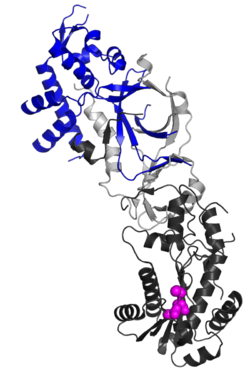| RNASEH2B | |||||||||||||||||||||||||||||||||||||||||||||||||||
|---|---|---|---|---|---|---|---|---|---|---|---|---|---|---|---|---|---|---|---|---|---|---|---|---|---|---|---|---|---|---|---|---|---|---|---|---|---|---|---|---|---|---|---|---|---|---|---|---|---|---|---|
 | |||||||||||||||||||||||||||||||||||||||||||||||||||
| |||||||||||||||||||||||||||||||||||||||||||||||||||
| Identifiers | |||||||||||||||||||||||||||||||||||||||||||||||||||
| Aliases | RNASEH2B, AGS2, DLEU8, ribonuclease H2 subunit B | ||||||||||||||||||||||||||||||||||||||||||||||||||
| External IDs | OMIM: 610326 MGI: 1914403 HomoloGene: 41572 GeneCards: RNASEH2B | ||||||||||||||||||||||||||||||||||||||||||||||||||
| |||||||||||||||||||||||||||||||||||||||||||||||||||
| |||||||||||||||||||||||||||||||||||||||||||||||||||
| |||||||||||||||||||||||||||||||||||||||||||||||||||
| |||||||||||||||||||||||||||||||||||||||||||||||||||
| |||||||||||||||||||||||||||||||||||||||||||||||||||
| Wikidata | |||||||||||||||||||||||||||||||||||||||||||||||||||
| |||||||||||||||||||||||||||||||||||||||||||||||||||
Ribonuclease H2, subunit B is a protein in humans is encoded by the RNASEH2B gene.[5] RNase H2 is composed of a single catalytic subunit (A) and two non-catalytic subunits (B and C), and degrades the RNA of RNA:DNA hybrids. The non-catalytic B subunit of RNase H2 is thought to play a role in DNA replication.[5]
Mutations in this gene are a cause of Aicardi-Goutieres syndrome type 2 (AGS2).[5][6]
Mutagenesis studies[edit]
RNASEH2B gene knockout in mice leads to early embryonic lethality, hence genetically engineered mice with a premature stop codon in exon 7 Rnaseh2b was created.[7] It was hypothesized that growth arrest was a consequence of a p53-dependent DNA damage response associated with the accumulation of single RN in genomic DNA.
Ribonucleotide accumulate in RNASEH2 null cells as a consequence of incorporation by DNA polymerases. Ribonucleotide incorporation occurs in metazoans. These lesions are harmful to mammalian cells, and their removal is required for mouse embryonic development. Lesions are single or diRN covalently incorporated into genomic DNA, at a frequency of approximately 1,000,000 sites per cell, making it the most common endogenous base lesion in the mammalian genome. These lesions are best explained by the misincorporation of the major replicative polymerases.
RNASEH2 is a genome surveillance enzyme required for ribonucleotide removal. Ribonucleotide accumulation in genomic DNA of RNASEH2 null mice implicates the RNASEH2 complex in the maintenance of genome integrity. These ribonucleotide changes are likely to be harmful, as their ribose 2’-hydroxyl group increases the susceptibility of the adjacent phosphodiester bond to hydrolysis. Actually, they [who?] report that the ribonucleotides are being incorporated 1 every ~7,600 nt in null cells = 1,300,000 lesions per cell. This have the same order of magnitude predicted from in vitro incorporation rates by eukaryotic replicative polymerases.
Misincorporated ribonucleotide induce DNA damage. It is not that the ribonucleotides do not prevent replication; rather, polDNA can tolerate templates with ribonucleotides, having normal early embryogenesis. The problem appears with excessive numbers of ribonucleotides. DNA damage response signaling is possibly activated by the incorporation of ribonucleotides in difficult-to-replicate regions or near other detrimental lesions. They also found chromosomal rearrangements: DNA breaks may originate by replication fork collapse or hydrolysis of RN on opposing DNA strands. Also, the marked activation of DNA damage signaling in embryos may produce a p53-mediated inhibition of proliferation that might contribute to the lethality of null embryos.
Ribonucleotide incorporation in health and disease[edit]
Previous studies reported only two contexts where there is stable incorporation of ribonucleotides:
1). diRibonucleotides in S. pombe may be a signal to initiate homologous recombination.
2). Ribonucleotides in mtDNA (Mouse and HeLa cells).
Low levels of ribonucleotides incorporation in the nuclear genome may be tolerated. Aberrant nucleic acid substrates, generated by repair pathways non-RNaseH2 dependent (due to reduced RNASEH2 activity in Aicardi-Goutières Syndrome) are thought to drive innate immune response [citation needed]. Alternatively, ribonucleotides might induce DNA-damage response signaling that by itself may stimulates interferon production.
Ribonucleotides can be highly deleterious to the mammalian cell, causing genome instability, and that the RNASEH2 is a critical enzyme for ensuring the integrity of genomic DNA. It also calls for attention and interest towards the pathway(s) that remove ribonucleotides from genomic DNA, the site and nature of ribonucleotides, induced DNA damage, and the distribution of ribonucleotides in the genome. Knowing this, understanding may be gained about the pathological and physiological roles of RN in genomic DNA, of significance to both nucleic acid-driven autoimmunity and carcinogenesis.
References[edit]
- ^ a b c GRCh38: Ensembl release 89: ENSG00000136104 – Ensembl, May 2017
- ^ a b c GRCm38: Ensembl release 89: ENSMUSG00000021932 – Ensembl, May 2017
- ^ "Human PubMed Reference:". National Center for Biotechnology Information, U.S. National Library of Medicine.
- ^ "Mouse PubMed Reference:". National Center for Biotechnology Information, U.S. National Library of Medicine.
- ^ a b c "ribonuclease H2, subunit B". Retrieved 2011-12-04.
- ^ Crow YJ, Leitch A, Hayward BE, Garner A, Parmar R, Griffith E, et al. (August 2006). "Mutations in genes encoding ribonuclease H2 subunits cause Aicardi-Goutières syndrome and mimic congenital viral brain infection". Nature Genetics. 38 (8): 910–916. doi:10.1038/ng1842. PMID 16845400. S2CID 8076225.
- ^ Reijns MA, Rabe B, Rigby RE, Mill P, Astell KR, Lettice LA, et al. (May 2012). "Enzymatic removal of ribonucleotides from DNA is essential for mammalian genome integrity and development". Cell. 149 (5): 1008–1022. doi:10.1016/j.cell.2012.04.011. PMC 3383994. PMID 22579044.
Further reading[edit]
- Chon H, Vassilev A, DePamphilis ML, Zhao Y, Zhang J, Burgers PM, et al. (January 2009). "Contributions of the two accessory subunits, RNASEH2B and RNASEH2C, to the activity and properties of the human RNase H2 complex". Nucleic Acids Research. 37 (1): 96–110. doi:10.1093/nar/gkn913. PMC 2615623. PMID 19015152.
- Crow YJ, Livingston JH (June 2008). "Aicardi-Goutières syndrome: an important Mendelian mimic of congenital infection". Developmental Medicine and Child Neurology. 50 (6): 410–416. doi:10.1111/j.1469-8749.2008.02062.x. PMID 18422679. S2CID 36342200.
- Ali M, Highet LJ, Lacombe D, Goizet C, King MD, Tacke U, et al. (May 2006). "A second locus for Aicardi-Goutieres syndrome at chromosome 13q14-21". Journal of Medical Genetics. 43 (5): 444–450. doi:10.1136/jmg.2005.031880. PMC 2649012. PMID 15908569.



